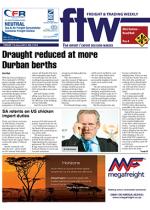The new R3.4-billion container
terminal at Walvis Bay
could see it placing further
competitive pressure on SA
ports, according to Ron Frick,
MD of DAL Agency – which
acts for Deutsche Afrika
Linien (DAL) in the SA Europe
Container Service (Saecs).
“It is very impressive,” he told
FTW after a recent visit there.
“And, once complete, I am sure
it will compete, for example,
with Coega as a transhipment
hub.”
And the plans for this new
terminal certainly make for
interesting reading.
It has been designed as a
trade hub for the region with
Namport’s strategy centred
on adopting a hub-andspoke
distribution model
for transhipment serving
the South, Central and West
African coastline and a
gateway for transit traffic
for the Southern African
Development Community
(SADC) landlocked countries.
It also provides the shortest
direct route to Europe and the
Americas.
Namport also sees Africa’s
potential for growth being
quite high and expects freight
demand to double by 2020
and increase by a factor of
six by 2040. Transit traffic
from landlocked countries is
expected to increase by 10-14
times over the next 30 years.
And for the SADC, this traffic
will increase from 13 million
tonnes to 148m.
The new terminal is
currently being constructed on
30 hectares of new land being
reclaimed from the channel
at Walvis Bay, a project that
is scheduled for completion in
February next year, followed by
the quay walls by April and the
construction of revetment by
August.
China Harbour Engineering
Company (CHEC), which is
constructing the terminal, said
the Phase 1 work is on schedule
for completion in 2017.
The expansion includes
the construction of a modern
container terminal, adding
600 metres of quay length to
the existing 1 500m and will
add 650 000 TEUs per annum
capacity to the existing
350 000 TEUs – totalling
1 000 000 TEUs.
Phase 1 of the project,
according to the Namport port
engineer, Elzevir Gelderbloem:
“will improve our port services
at least until 2020 when we
will have to undergo the same
process again.”
This, he added, will enable
the port to take advantage
of the congestion and poor
productivity in Eastern
and Southern African ports
(Mozambique, Angola and to a
lesser extent SA).
“There will be a particular
concentration on that West
African coastline because of
Walvis Bay’s prime position,”
said Frick. “But it could also
see pendulum carriers on
the Far East-South America
trade making a deviation from
Coega.
“With Walvis having a future
draught of 14m plus, it will also
be able to accommodate these
larger ships.
“Transhipment costs,
however, will be the final
decider.”
Frick also suggested that it
would certainly make the port
scenario on the tip of Africa
that much more interesting.
“It will add an extra option,”
he said.
He saw Walvis remaining
dominantly an export port.
“It mainly concentrates on
heavy 20 foot (6 metre) boxes
carrying commodities like
minerals.”
And, if the TransKalahari
and TransCunene Corridors
develop, Frick felt that
Walvis Bay would add to its
advantages. “Cargo,” he said,
“like water, flows where there
is least resistance.
“And, for countries that have
to bypass others to get to SA
ports – for example the DRC,
Zambia, Angola and Malawi
– Namibia faces less of such
resistance.
“Being able to reduce this
bureaucratic muddle will
certainly add to its attraction.”
CAPTION
Walvis Bay competing for transhipment traffic … transit traffic from landlocked countries is expected to increase by 10-14
times over the next 30 years.

